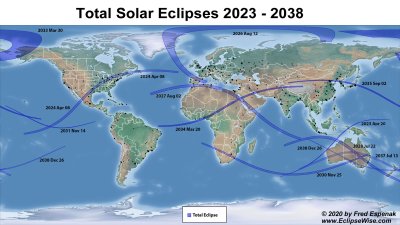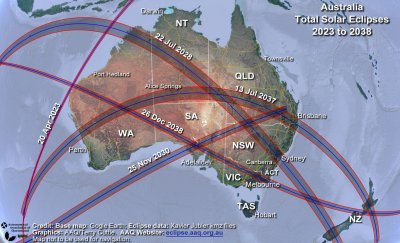Australia's 5 eclipses in the world context
Australia's 5 eclipses in the world context
It is extremely rare for such a concentrated sequence of eclipses to occur in such a short period in one country or continent. During the period 2023 to 2038, the number of eclipses crossing each continent will be: one in North America, none in South America, two in Europe (both in Spain), three in Africa, two in Asia and an amazing five in the Australian region. Of the twelve total solar eclipses in this period, five cross Australia and three of these cross New Zealand.
Figure 1 below shows the locations of total solar eclipses across the world in the period 2023 to 2038.

Australian Eclipses
The dates and general area of each of the 5 Australian total solar eclipses are:
- 20 April 2023: crossing North West Cape in Western Australia
- 22 July 2028: crossing the continent from the Kimberley region, Northern Territory, southwest Queensland, New South Wales including Sydney and South Island of New Zealand
- 25 November 2030: South Australia, northwest New South Wales and southern Queensland
- 13 July 2037: crossing the continent from southern Western Australia, southern Northern Territory, southern Queensland including Brisbane and North Island of New Zealand
- 26 December 2038: crossing the continent from central Western Australia, South Australia, Victoria / New South Wales border and New Zealand
The paths of totality of these eclipses are shown in Figure 2 below.

Get yourself to totality
It is often said that everyone must experience at least one total solar eclipse in their lifetime. To experience this amazing spectacle, it is necessary to be positioned on one of the paths of totality. All Australians have an opportunity with these eclipses as there is a path of totality not far away.
Three of these eclipses are coast to coast (west to east). Most states get a reasonable share; four for Western Australia, four for New South Wales, three for South Australia, three for Queensland, two for Northern Territory and one for Victoria. There are three for New Zealand.
After these five eclipses there will not be another on the Australian mainland for another 28 years, and after these five, there will only be four more until the end of the century.
This really is the opportunity of a lifetime!
Some of the diagrams on this website show the maximum percentage of partial eclipse in the areas surrounding the path of totality. Do not be misled into thinking that near enough is good enough for a total solar eclipse. A 99% eclipse is still a partial eclipse and there will be none of the amazing experiences of a total solar eclipse. Because the change in level of brightness from full Sun to being in a total eclipse is so great, even if you are close to the path of totality and the Sun is covered 99%, the light is still up to 1000 times brighter than in the path of totality. It is too bright to see the Sun’s outer atmosphere, the corona, the colourful chromosphere and prominences on the Sun’s upper surface and you will not be enveloped by the dark Moon’s shadow or see the amazing “diamond ring” or the 360° sunset colours.
